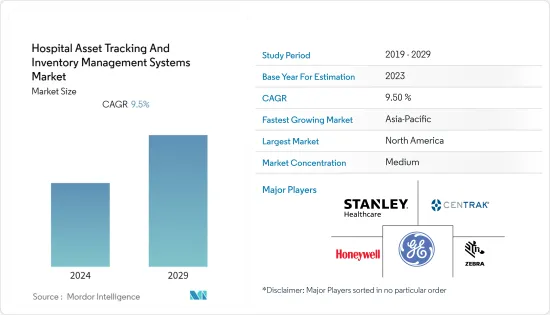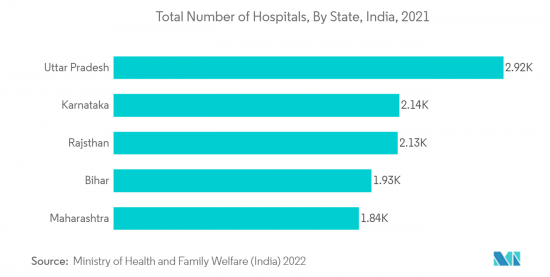 |
市場調査レポート
商品コード
1408007
病院資産向け追跡・在庫管理システム- 市場シェア分析、産業動向・統計、2024年~2029年の成長予測Hospital Asset Tracking And Inventory Management Systems - Market Share Analysis, Industry Trends & Statistics, Growth Forecasts 2024 - 2029 |
||||||
● お客様のご希望に応じて、既存データの加工や未掲載情報(例:国別セグメント)の追加などの対応が可能です。 詳細はお問い合わせください。
| 病院資産向け追跡・在庫管理システム- 市場シェア分析、産業動向・統計、2024年~2029年の成長予測 |
|
出版日: 2024年01月04日
発行: Mordor Intelligence
ページ情報: 英文 120 Pages
納期: 2~3営業日
|
- 全表示
- 概要
- 目次
病院資産向け追跡・在庫管理システム市場は、予測期間中にCAGR 9.5%を記録する見込みです。

世界的に、病院部門は、より良い追跡システムの欠如、医療機器の不適切な管理、と不十分なスタッフ管理により、COVID-19アウトブレイクの初期段階で大きな影響を示しました。そのため、病院における資産追跡・在庫管理を改善するための技術的ソリューションの必要性が浮き彫りになった。例えば、米国保健社会福祉省が2020年に実施した全国調査の結果によると、COVID-19パンデミックの間、病院は適切なスタッフレベルを維持できず、スタッフに十分なサポートを提供できなかったと報告されています。いくつかの国では、COVID-19の流行中、病院で重要な医療機器が不足したと報告しています。米国FDAは、米国人、特に医療機器を使用または購入する人々に透明性を提供するため、2020年に機器不足リストを公表しました。このような事例は、病院資産向け追跡・在庫管理業界の主要企業に有利な機会を提供し、パンデミック期における市場の成長を促進しました。しかし、システムの需要という点では、市場はパンデミック前の状態に達しており、今後数年間は力強い成長が見込まれます。
さらに、医療環境におけるRTLSとRFIDの使用の急増、資産管理の需要の増加、病院支出の増加、市場内での製品の発売や承認などの戦略的開拓が、分析期間中の市場の成長を促進すると予測されます。2022年6月、シリコンラボは、高精度で低消費電力のBluetoothデバイスを使用した新しいBluetoothロケーションサービスソリューションを発表し、資産の追跡、屋内ナビゲーションの改善、サブメートル精度でより正確にタグを見つけることができるソフトウェアを提供しました。同プラットフォームは同年、資産管理と資産活用のための医療向けIoTを提供するボルダ・技術社に採用されました。同社はさらに、シリコン・ラボの革新的なアプローチを利用した病院追跡製品やサービスを提供すると述べています。このような新製品の発売により、研究対象市場は今後数年間で大きく成長すると予想されます。
また、より優れた資産追跡ソリューションに対する認識やニーズの高まり、技術革新、製品発表、提携、買収などが市場の成長を後押ししています。例えば、2021年11月、Philips N.V.は、リアルタイムの業務意思決定支援を提供するPerformance Flow製品を設計しました。Performance Flowは、従業員、機械、施設間の生産性を最大化し、ハードウェア、ソフトウェア、データ分析、ワークフロー分析、在庫管理で構成される完全に統合されたソリューションを提供するほか、病院が最適な技術を選択し、規制負担のリスクを低減するための独立したコンサルティングも行っています。
したがって、前述の要因により、調査対象市場は分析期間中に成長を遂げると予想されます。しかし、設置やメンテナンスのコストが高いことが、市場の成長を阻害する可能性が高いです。
病院資産向け追跡・在庫管理システム市場動向
無線自動識別(RFID)セグメントは予測期間中に力強い成長が見込まれる
RFID(Radio-frequency Identification)セグメントは予測期間中に大幅な成長が見込まれます。バーコード技術のように、RFIDはラベル上のバーコードを光学的にスキャンするのではなく、電波を使ってタグからデータを読み取る。タグやラベルを見ることなく保存されたデータを読み取るRFIDの能力は、その主要利点の1つであり、この分野の成長を促進すると予想されています。
最近では、医療におけるパッシブ超高周波無線識別(UHF RFID)無線技術の使用が増加しています。UHF帯では、RFIDシステムは860~930MHzの範囲で動作します。このため、RFIDは病院全体で使用されるモノのインターネットに入力データを提供する主要な無線技術となっています。さらに、RFIDタグにおけるさまざまな企業による技術革新が、RFIDタグを費用対効果の高いものとし、病院の資産追跡や在庫管理の必要性を高めていることが、このセグメントの成長を促進しています。例えば、2022年4月、TrackCore Inc.はTerso Solutionsと提携し、手作業による追跡プロセスで病院が経験するペインポイントに遭遇しました。これらの施設は、TrackCoreの電子カルテ(EHR)と企業資源計画(ERP)と連携してTersoのRFIDを利用することにより、自動化を通じて完全に準拠したワークフローを維持することができます。現在米国では900以上の病院がTrackCore, Inc.のサービスを利用しています。
さらに、病院数の増加は、病院がリソースを追跡するのに役立つため、RFIDの需要を増大させています。例えば、2022年4月に発表されたインド保健家族福祉省のデータによると、ウッタル・プラデシュ州はインドで最も病院数が多く、多科目病院の数は全国的に増加傾向にあります。
このように、前述の要因から、RFIDセグメントは分析期間を通じて市場で大きなシェアを獲得すると見られています。

北米が病院資産向け追跡・在庫管理システム市場を独占する見込み
北米は、病院数の増加、より良い医療インフラ、利用可能な技術に関する人々や医療業界利害関係者の認識、米国に市場参入企業が集中しているなどの要因により、市場を独占すると予想されます。2022年の米国病院協会のデータによると、2021年の米国の病院数は6,093施設でした。したがって、これらの病院の存在は、地域全体で資産追跡・在庫管理ソリューションの採用を必要とし、ひいては市場成長を促進します。
さらに、特に米国では、製品の発売、提携、買収が増加しており、市場の成長を後押ししています。例えば、2022年6月、Fresenius KabiはAmerisourceBergenと提携し、RFIDポートフォリオを拡大して病院の在庫管理を改善しました。Fresenius Kabi+RFIDの無線周波数タグ付き薬剤ポートフォリオは、AmerisourceBergenの薬剤トレイソリューションと互換性を持つことになります。アメリソース・バーゲン社は、米国の医薬品販売会社の一つであり、最先端のRFID(Radio Frequency Identification:無線自動認識)技術を利用した薬剤トレイ・ソリューションを提供し、病院における薬剤の在庫の可視化と追跡管理を支援しています。Fresenius Kabi+RFID医薬品のラベルに埋め込まれた高性能のRAIN RFIDタグには、病院が即座に在庫を識別、特定、管理するために必要な重要な情報が含まれています。
したがって、上記の要因から、調査対象市場の成長は北米地域で予測されます。
病院資産向け追跡・在庫管理システム産業概要
病院資産向け追跡・在庫管理システム市場は、世界的と地域的に事業を展開する複数の企業が存在するため、その性質上断片化されています。競合情勢には、大きな市場シェアを持ち、よく知られている数社の国際企業や地元企業の分析が含まれます。市場内の主要企業には、GE医療、Cybra Corporation、Stanley Healthcare、CenTrak Inc、Qorvo Inc、AiRISTA Flow Inc、Honeywell International Inc、Sonitor Technologies、Jadak-A Novanta Company、Midmark Corporation、Elpas Solutionsなどがあります。
その他の特典:
- エクセル形式の市場予測(ME)シート
- 3ヶ月間のアナリスト・サポート
目次
第1章 イントロダクション
- 調査の前提条件と市場定義
- 調査範囲
第2章 調査手法
第3章 エグゼクティブサマリー
第4章 市場力学
- 市場概要
- 市場促進要因
- 病院におけるRFIDとRTLS技術の需要の増加
- 病院におけるより良い資産管理への需要の高まり
- 医療施設改善のための病院支出の急増
- 市場抑制要因
- 設置とメンテナンスの高コスト
- ポーターのファイブフォース分析
- 新規参入業者の脅威
- 買い手/消費者の交渉力
- 供給企業の交渉力
- 代替品の脅威
- 競争企業間の敵対関係の強さ
第5章 市場セグメンテーション(市場規模-100万米ドル)
- 技術別
- 無線自動認識(RFID)
- リアルタイム位置特定システム(RTLS)
- バーコードスキャナー
- ソフトウェア分析
- その他
- 製品タイプ別
- モバイル機器
- 固定機器
- その他
- 用途別
- 機器・器具の追跡
- スタッフ・消耗品の追跡
- 地域別
- 北米
- 米国
- カナダ
- メキシコ
- 欧州
- ドイツ
- 英国
- フランス
- イタリア
- スペイン
- その他の欧州
- アジア太平洋
- 中国
- 日本
- インド
- オーストラリア
- 韓国
- その他のアジア太平洋
- 中東・アフリカ
- GCC諸国
- 南アフリカ
- その他の中東・アフリカ
- 南米
- ブラジル
- アルゼンチン
- その他の南米
- 北米
第6章 競合情勢
- 企業プロファイル
- GE Healthcare
- Honeywell International Inc.
- Stanley Healthcare
- Zebra Technologies Corp.
- CenTrak Inc.
- Qorvo Inc.
- AiRISTA Flow Inc.
- Cybra Corporation
- Sonitor Technologies
- Jadak-A Novanta Company(Thinkmagic)
- Midmark Corporation
- Elpas Solutions
第7章 市場機会と今後の動向

The hospital asset tracking and inventory management market is expected to register a CAGR of 9.5% over the forecast period.
Globally, the hospital sector witnessed a significant impact of the COVID-19 outbreak in its initial stage due to a lack of better tracking systems, improper management of medical devices, and poor staff management. Therefore, this highlighted the need for technological solutions for better asset tracking and inventory management in hospitals. For instance, the United States Department of Health and Human Services results of a national survey in 2020 stated that hospitals reported that they were not able to maintain adequate staffing levels or offer staff adequate support during the COVID-19 pandemic. Several countries reported that there was a shortage of crucial medical devices in hospitals during the COVID-19 outbreak. The US FDA published a device shortage list in 2020 to provide transparency to Americans, particularly those who use or purchase medical devices. Thus, such instances provided lucrative opportunities for key players within the hospital asset tracking and inventory management industry, thereby driving the market's growth during the pandemic phase. However, the market has reached its pre-pandemic nature in terms of demand for the systems and is expected to witness strong growth in the coming years.
Moreover, the upsurge in the use of RTLS and RFID in healthcare settings, growth in the demand for asset management, and increase in hospital spending, along with strategic developments such as product launches and approvals within the market are anticipated to drive the market's growth over the analysis period. In June 2022, Silicon Labs introduced its new Bluetooth location services solution using precise, low-power Bluetooth devices, which offers software that can track assets, improve indoor navigation, and more accurately find tags with sub-meter accuracy. In the same year, the platform was adopted by Borda Technology, which offers IoT for Healthcare for asset management and asset utilization. The company further stated that it will provide hospital tracking products and services using Silicon Labs' innovative approach. WIth such new product launches, the market studied is expected to grow significantly in the coming years.
In addition, the increasing awareness and need for better asset tracking solutions, innovation, product launches, partnerships, and acquisitions are boosting the market growth. For instance, in November 2021, Philips N.V. designed the Performance Flow product, which offers real-time operational decision support. Performance Flow maximizes productivity between employees, machinery, and facilities and offers a fully integrated solution made up of hardware, software, data analytics, workflow analysis, and inventory management, as well as independent consultancy to help hospitals choose the best technology and lower the risk of regulatory burden.
Therefore, owing to the aforementioned factors, the studied market is anticipated to witness growth over the analysis period. However, the high cost of installation and maintenance is likely to impede the market's growth.
Hospital Asset Tracking And Inventory Management Systems Market Trends
Radio-frequency identification (RFID) Segment is Expected to Witness Strong Growth Over the Forecast Period
The radio-frequency identification (RFID) segment is expected to witness substantial growth over the forecast period. Like barcode technology, RFID reads data from tags using radio waves rather than optically scanning the barcodes on labels. RFID's ability to read stored data without having to see the tag or label is one of its primary advantages, which is anticipated to drive the segment's growth.
In recent times, the use of passive ultra-high frequency radio frequency identification (UHF RFID) wireless technology in healthcare is on the rise. In the UHF band, RFID systems operate in the 860-930 MHz range. Owing to this, RFID is the leading wireless technology providing input data to the Internet of Things used across hospitals. Moreover, the innovations by different companies in RFID tags, making them a cost-effective and growing necessity for hospital asset tracking and inventory management, are driving the segment's growth. For instance, in April 2022, TrackCore Inc. partnered with Terso Solutions to encounter pain points experienced by hospitals with manual tracking processes. These facilities may maintain a completely compliant workflow through automation by utilizing Terso's RFID in conjunction with TrackCore's electronic health record (EHR) and enterprise resource planning (ERP) connections. Over 900 hospitals in the United States are currently served by TrackCore, Inc.
Additionally, the increasing number of hospitals is augmenting the demand for RFIDs as it helps hospitals to track their resources. For instance, as per the data from the Ministry of Health and Family Welfare (India) published in April 2022, Uttar Pradesh state had the largest number of hospitals in India and the number of multispecialty hospitals is on the rise all over the country.
Thus, due to the aforementioned factors, the RFID segment is expected to garner a significant share of the market throughout the analysis period.

North America is Expected to Dominate the Hospital Asset Tracking and Inventory Management Systems Market
North America is expected to dominate the market owing to factors such as the growing number of hospitals, better healthcare infrastructure, awareness among people and healthcare industry stakeholders about available technologies, and the high concentration of market players in the United States. According to the American Hospital Association data for 2022, there were a total of 6,093 hospitals in the United States during the year 2021. Thus, the presence of these hospitals necessitates the adoption of asset tracking and inventory management solutions across the region, in turn, driving market growth.
Moreover, the increasing number of product launches, partnerships, and acquisitions, particularly in the United States, is bolstering the market's growth. For instance, in June 2022, Fresenius Kabi partnered with AmerisourceBergen to expand its RFID portfolio to improve hospital inventory management. Fresenius Kabi +RFID's portfolio of radio frequency-tagged medications will now be compatible with AmerisourceBergen's medication tray solution. AmerisourceBergen, one of the pharmaceutical distributors in the United States, offers a medication tray solution that uses cutting-edge Radio Frequency Identification (RFID) technology to assist hospitals in better managing their medication inventory visibility and tracking. A high-performance RAIN RFID tag implanted on the label of Fresenius Kabi +RFID pharmaceuticals contains the vital information hospitals need to instantly identify, locate, and manage their inventory.
Therefore, owing to the above-mentioned factors, the growth of the studied market is anticipated in the North American region.
Hospital Asset Tracking And Inventory Management Systems Industry Overview
The hospital asset tracking and inventory management systems market is fragmented in nature due to the presence of several companies operating globally as well as regionally. The competitive landscape includes an analysis of a few international as well as local companies that hold significant market share and are well known. Some of the key players within the market include GE Healthcare, Cybra Corporation, Stanley Healthcare, CenTrak Inc, Qorvo Inc, AiRISTA Flow Inc, Honeywell International Inc, Sonitor Technologies, Jadak- A Novanta Company, Midmark Corporation, Elpas Solutions among others.
Additional Benefits:
- The market estimate (ME) sheet in Excel format
- 3 months of analyst support
TABLE OF CONTENTS
1 INTRODUCTION
- 1.1 Study Assumptions and Market Definition
- 1.2 Scope of the Study
2 RESEARCH METHODOLOGY
3 EXECUTIVE SUMMARY
4 MARKET DYNAMICS
- 4.1 Market Overview
- 4.2 Market Drivers
- 4.2.1 Increasing demand of RFID and RTLS Technology Across Hospital Settings
- 4.2.2 Growing Demand for Better Asset Management in Hospitals
- 4.2.3 Surge in Hospital Spending for Improved Healthcare Facilities
- 4.3 Market Restraints
- 4.3.1 High Cost of Installation and Maintenance
- 4.4 Porter's Five Force Analysis
- 4.4.1 Threat of New Entrants
- 4.4.2 Bargaining Power of Buyers/Consumers
- 4.4.3 Bargaining Power of Suppliers
- 4.4.4 Threat of Substitute Products
- 4.4.5 Intensity of Competitive Rivalry
5 MARKET SEGMENTATION (Market Size by Value - USD million)
- 5.1 By Technology
- 5.1.1 Radio-frequency identification (RFID)
- 5.1.2 Real-time locating systems (RTLS)
- 5.1.3 Barcode Scanners
- 5.1.4 Software Analytics
- 5.1.5 Others
- 5.2 By Product Type
- 5.2.1 Mobile Equipment
- 5.2.2 Fixed Equipment
- 5.2.3 Other Inventories
- 5.3 By Application
- 5.3.1 Device & Instruments Tracking
- 5.3.2 Staff & Supplies Tracking
- 5.4 Geography
- 5.4.1 North America
- 5.4.1.1 United States
- 5.4.1.2 Canada
- 5.4.1.3 Mexico
- 5.4.2 Europe
- 5.4.2.1 Germany
- 5.4.2.2 United Kingdom
- 5.4.2.3 France
- 5.4.2.4 Italy
- 5.4.2.5 Spain
- 5.4.2.6 Rest of Europe
- 5.4.3 Asia-Pacific
- 5.4.3.1 China
- 5.4.3.2 Japan
- 5.4.3.3 India
- 5.4.3.4 Australia
- 5.4.3.5 South Korea
- 5.4.3.6 Rest of Asia-Pacific
- 5.4.4 Middle East and Africa
- 5.4.4.1 GCC
- 5.4.4.2 South Africa
- 5.4.4.3 Rest of Middle East and Africa
- 5.4.5 South America
- 5.4.5.1 Brazil
- 5.4.5.2 Argentina
- 5.4.5.3 Rest of South America
- 5.4.1 North America
6 COMPETITIVE LANDSCAPE
- 6.1 Company Profiles
- 6.1.1 GE Healthcare
- 6.1.2 Honeywell International Inc.
- 6.1.3 Stanley Healthcare
- 6.1.4 Zebra Technologies Corp.
- 6.1.5 CenTrak Inc.
- 6.1.6 Qorvo Inc.
- 6.1.7 AiRISTA Flow Inc.
- 6.1.8 Cybra Corporation
- 6.1.9 Sonitor Technologies
- 6.1.10 Jadak- A Novanta Company (Thinkmagic)
- 6.1.11 Midmark Corporation
- 6.1.12 Elpas Solutions
